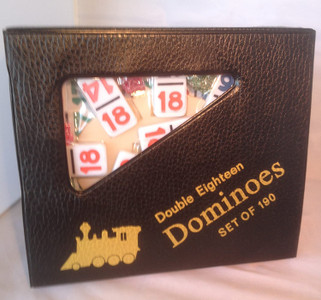 Loading... Please wait...
Loading... Please wait...- Home
- Chickenfoot Domino Rules
Categories
Chickenfoot Domino Rules
Chickenfoot Domino Rules
Number of Players:2 and up
Type of Dominoes Used: Double 9 or 12
Type of Game: Blocking Game
Object of the game:
To be the player with the lowest score at the end of the game. 
Rules: Two different formations are made: the double Chickenfoot and the Chickenfoot. The double Chickenfoot is made at the beginning of each hand by playing 6 tiles diagonally, 3 on each side of the set tile. Chickenfoot are made throughout the hand by playing 3 tiles diagonally on one side of a double played during the game. Tiles played diagonally on the double tile are called “Chickentoes.” A Chickenfoot or a double Chickenfoot must have all the Chickentoes before any other plays can be made.
Great Video that explains chickenfoot
Number of tiles drawn:
Each player draws an equal number of tiles from the “chicken yard.” For example: If 2 play, each draws 20 tiles; if 8 play, each draws 6 tiles. There are 55 tiles in the set of a Double 9 set. (If using a Double 12 or 15 set, make adjustments proportionately.) Tiles left after each player draws remain in the chicken yard to be drawn from during the hand.
Set:
Player holding the 9-9 makes the first play of the game. Subsequent games would begin with the next-lowest double tile (8-8, 7-7, 6-6 and so on, the last game beginning with the 0-0 tile). If no one holds the correct double tile to begin that particular hand, players may agree to either 1) go to the next-lowest double or 2) reshuffle all the tiles and draw new hands. Play continues to the left. The next 6 players must be made on the 9-9 tile, 3 tiles played diagonally on each side of the 9-9 tile. This formation is called a double Chickenfoot. To do this, players must match a tile from their hand of the 9 suit to the 9-9 set tile. If 6 tiles have not been played on the 9-9 set and a player does not hold a tile from the 9 suit in his hand, he may draw one tile from the chicken yard. If he draws a tile with a 9 end, he plays it on the set tile. If he does not draw a tile from the 9 suit, he must pass his turn to the player to his left. After 6 tiles have been played on the 9-9 set tile, plays can be made on any of the 6 Chickentoes by matching tiles end to end, until someone plays a double tile. Once a double tile has been played on one of the Chickentoes, the next three plays must be made on the double tile before plays can be made anywhere else in the layout. This formation of 3 tiles played on the double tile is called a Chickenfoot. Once the new Chickenfoot has been completed by playing 3 tiles diagonally on one side of a double tile, players may return to adding tiles to any of the chicken toes until someone plays another double.
Game End / Scoring
The game ends once a player plays all the tiles in his hand or when the game ends in block because none of the players are able to make a play and there are no tiles in the Chickenyard to draw from. Players must count the dots on the tiles remaining in their hand (1 point per 1 dot) and record their score. Remember that the player caught having the 0-0 gets 50 points. For the next hand, tiles are reshuffled and each player draws the same number of tiles from the chicken yard as he or she did at the beginning of the previous hand played. The second hand begins with the 8-8 tile; the third hand with the 7-7 tile and so on. For a longer game players may choose to continue playing by starting another hand with the 1-1 tile following the hand that began with the 0-0 tile as set. Subsequent hands would begin with the next highest double played as set (2-2, 3-3, and so on up to the last hand beginning with the 9-9 tile).
Rule Variation
50 points are added to your score at the end of a hand if you are left holding the 0-0 tile.






